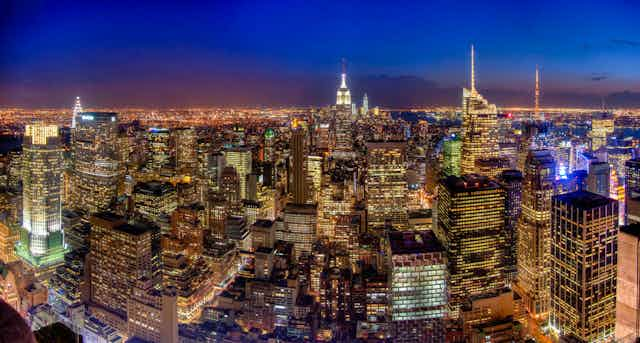The term “gentrification” does not quite capture the massive changes that have been happening in a growing number of cities worldwide in the last few years. In mid-2014 to 2015 alone, more than a trillion dollars was invested in real estate, in just 100 cities across North America, Europe and Asia; this is excluding properties priced under US$5m and sites available for development.
Something else is happening. Urban land – not just buildings, but also undeveloped lots – is considered a good investment at a time when financial markets are shaky. As a result, worldwide investment in urban land is increasing rapidly.
There are diverse indications of this, which I explore in depth in my book, Expulsions. For one, the top 100 cities – as ranked by level of property investment – account for 10% of the world population, but 30% of the world’s GDP (its overall economic output) and 76% of the world’s property investment. So wealth is clearly being concentrated into a select group of urban areas.
Another disturbing sign is that worldwide real estate assets amount to US$217 trillion, according to Savill (one of the leading expert firms on real estate). This represents 60% of the value of all global assets, including equities, bonds and gold. And let’s not forget that when a piece of real estate becomes an asset, it has been financialised – which opens up all kinds of possibilities to raise the property’s value.
That said, it’s important to keep things in perspective. Although the world’s GDP is about US$270 trillion, this is dwarfed by the value of finance: measured by outstanding derivatives (the basic measure for finance), it is worth over a quadrillion dollars.
Home, sweet home?
There are a couple of signals that this trend has something to do with investment, rather than, say, more people moving to these cities to buy a house and start a family. Let’s focus on some of the most desirable luxury buildings in Manhattan in New York – though we could have taken any of 25 or even 50 major cities in the world.
The trends I describe capture something about the desirability of investing not only in property but, perhaps especially, in urban land. This is significant in a world where much land is dying – due to desertification, floods, mining, plantation agriculture, deforestation or poisoning from mining operations.
In 2014, 54% of sales of real estate priced over US$5m in Manhattan were made to shell companies –– companies used as a front for other operations. If we break it down into specific buildings, and take the most famous and highly-valued Manhattan buildings we find similar numbers.

Here are some relevant cases for the last few years. In the Warner Center in Manhattan, 122 of the 192 condos are owned by people who used shell companies, which hide their identities. In the Bloomberg Tower, 57% of condos are owned by shell companies. And in The Plaza, 69% of condos are owned by shell companies. We can observe the same trend in other cities, such as London, where 22,000 properties had been left empty for more than six months, as of February 2016.
Several major US cities saw rising investments (both national and foreign) in urban properties, from offices to high-rise apartment buildings, hotels and retail. New York led, with US$70 billion from mid-2014 to -15, followed by Los Angeles Metro and San Francisco Metro. These top recipient cities were followed by Chicago, Washington DC, Dallas and several others.
We see similar trends abroad, with London, Paris and Tokyo among the major recipients. In some cities, it was mostly foreign investment: for example, in London, Dublin, and Amsterdam-Randstadt. In others, it was primarily domestic investment, such as New York, Moscow and Beijing. And in many it was 50:50, as a result of the growth of foreign investment – notably in Paris, Sydney, and Vienna.
Who owns the city?
Periods of high levels of foreign investment have recurred in cities such as New York, London and Hong Kong over the decades. When I was doing my research for The Global City in the 1980s, I found multiple nationalities in the ownership of much of the City of London. In New York and Los Angeles, the acquisitions by Japanese and Middle Eastern investors had become more prominent, alongside the long-standing European investments.
But what marked these investments in the 1980s was utility. The buyers wanted and needed to be in New York or London. Today, the high incidence of shell companies is more about storing money and hiding it, than actually using the buildings.

These days, I would argue that whether the investment is foreign or national may matter less than the fact that it is corporate. Corporate investment tends toward large-scale projects; either in large developments, or in smaller urban plots that are assembled into one larger plot. Often, existing properties are torn down to build entire new mega-projects – taller, larger, fancier than what went before.
This kind of large-scale urban development entails significant shifts in ownership; from small or medium businesses to large corporations, or from public to private. Some of the most noxious “site assembly” developments happen when a single owner buys one or two city blocks, and the city authorities cave in to their requirements by eliminating little streets and parks, and privatising everything.
We are witnessing a deep history in the making: a systematic transformation in the pattern of land ownership in some of our major cities. Whether it’s national or foreign, large-scale corporate investment absorbs much of the public tissue of streets and squares, and street-level commerce. It shrinks the texture and scale of spaces that are accessible to the public, and ultimately changes the very character of the city. If we’re to safeguard equity, democracy and rights in urban areas, we must first ask ourselves: who owns the city?

